Project Report: Foundation of Mathematical Skills - Finance Project
VerifiedAdded on 2020/05/03
|6
|959
|127
Project
AI Summary
This project report provides a comprehensive financial analysis, addressing key concepts such as Net Present Value (NPV) and EMI calculations. The report evaluates two projects, determining the more beneficial investment based on NPV calculations, and suggests investing in Project A due to its higher returns. It also includes detailed calculations for loan amortization, determining the loan period and EMI amounts under different scenarios. Furthermore, the report delves into the Global Financial Crisis of 2008, discussing its origins in the US market, its impact on international economies, and the factors that exacerbated the crisis, such as asymmetric information. The report concludes by noting the gradual recovery of financial markets and the resurgence of investor confidence.
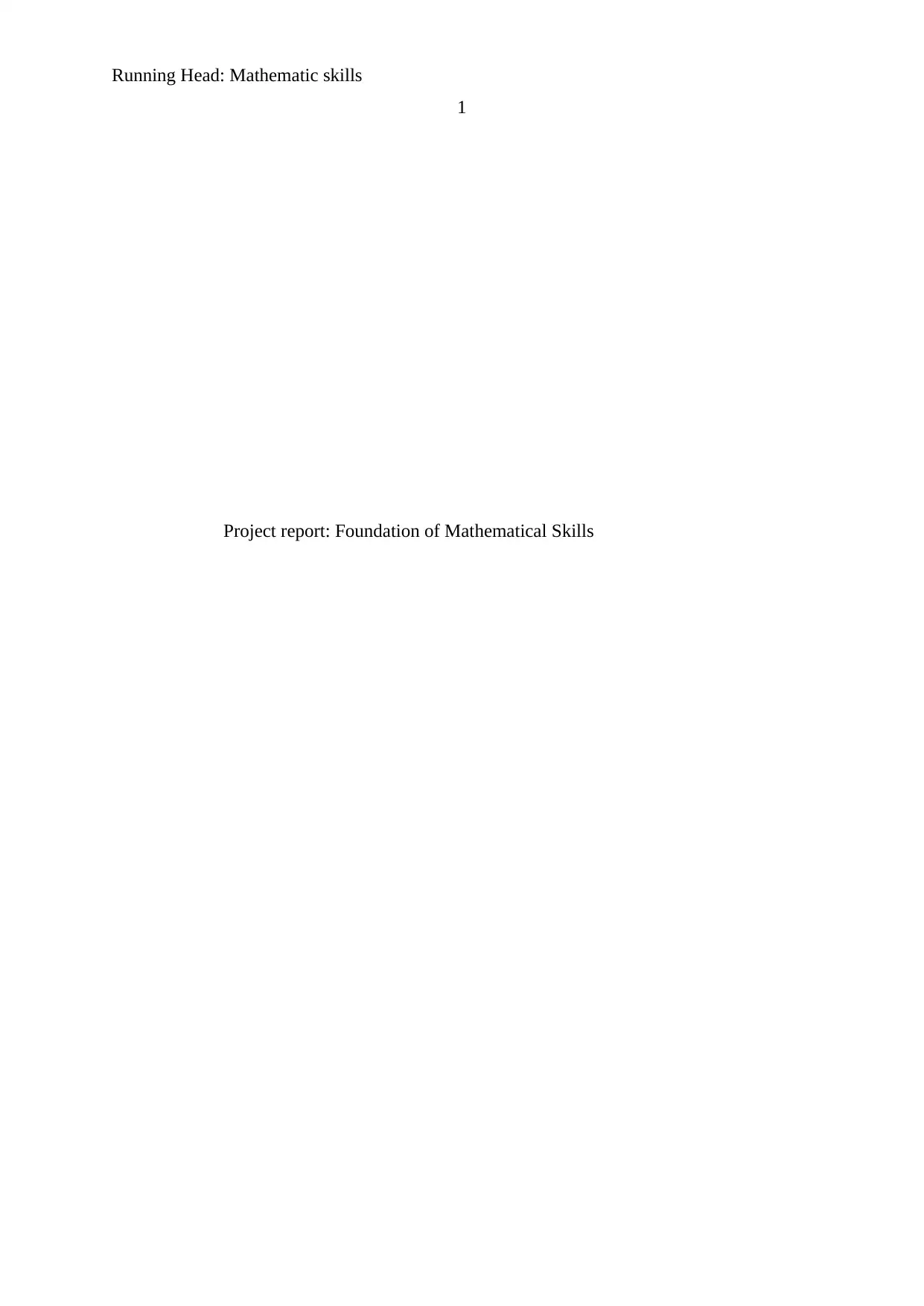
Running Head: Mathematic skills
1
Project report: Foundation of Mathematical Skills
1
Project report: Foundation of Mathematical Skills
Paraphrase This Document
Need a fresh take? Get an instant paraphrase of this document with our AI Paraphraser
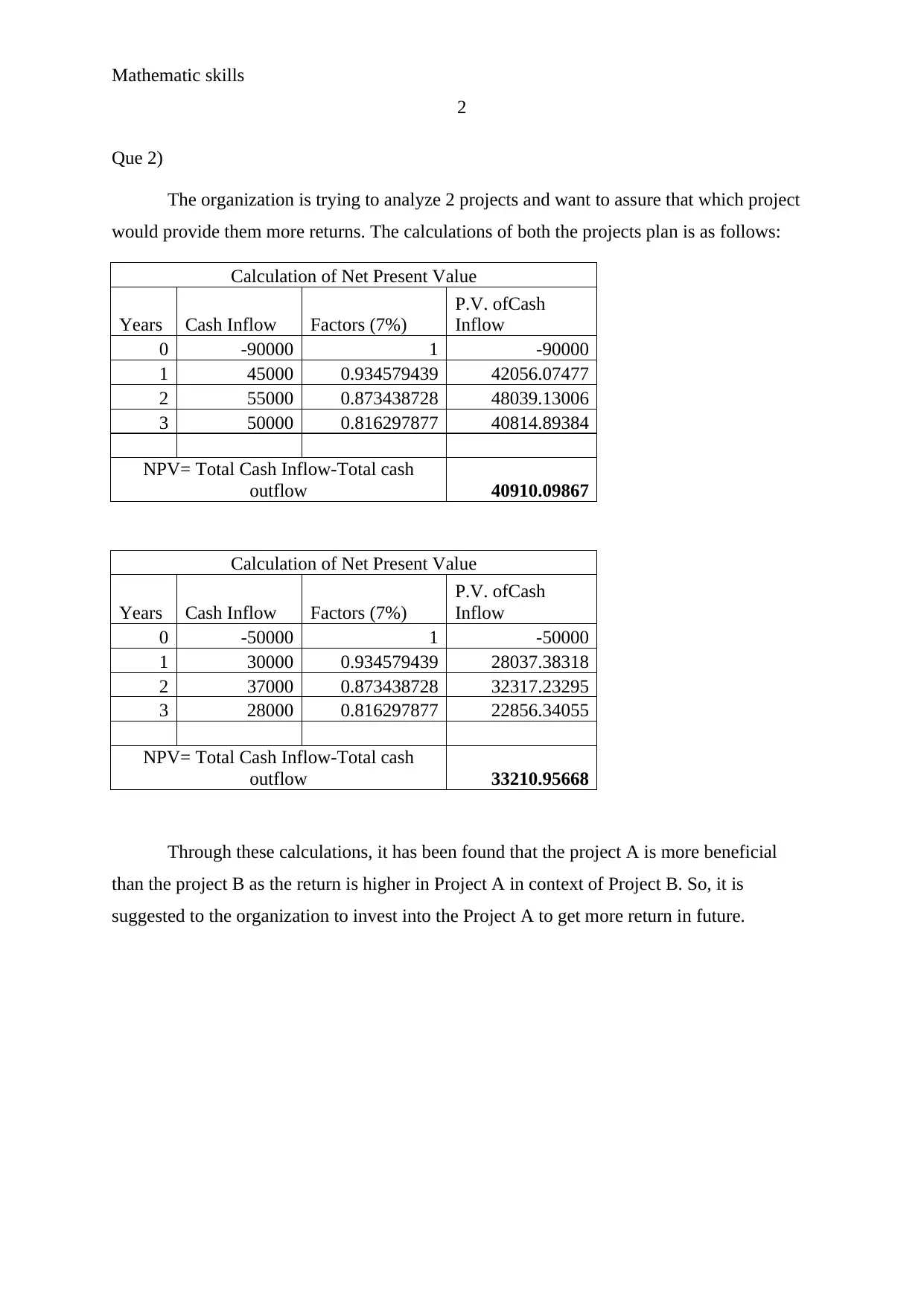
Mathematic skills
2
Que 2)
The organization is trying to analyze 2 projects and want to assure that which project
would provide them more returns. The calculations of both the projects plan is as follows:
Calculation of Net Present Value
Years Cash Inflow Factors (7%)
P.V. ofCash
Inflow
0 -90000 1 -90000
1 45000 0.934579439 42056.07477
2 55000 0.873438728 48039.13006
3 50000 0.816297877 40814.89384
NPV= Total Cash Inflow-Total cash
outflow 40910.09867
Calculation of Net Present Value
Years Cash Inflow Factors (7%)
P.V. ofCash
Inflow
0 -50000 1 -50000
1 30000 0.934579439 28037.38318
2 37000 0.873438728 32317.23295
3 28000 0.816297877 22856.34055
NPV= Total Cash Inflow-Total cash
outflow 33210.95668
Through these calculations, it has been found that the project A is more beneficial
than the project B as the return is higher in Project A in context of Project B. So, it is
suggested to the organization to invest into the Project A to get more return in future.
2
Que 2)
The organization is trying to analyze 2 projects and want to assure that which project
would provide them more returns. The calculations of both the projects plan is as follows:
Calculation of Net Present Value
Years Cash Inflow Factors (7%)
P.V. ofCash
Inflow
0 -90000 1 -90000
1 45000 0.934579439 42056.07477
2 55000 0.873438728 48039.13006
3 50000 0.816297877 40814.89384
NPV= Total Cash Inflow-Total cash
outflow 40910.09867
Calculation of Net Present Value
Years Cash Inflow Factors (7%)
P.V. ofCash
Inflow
0 -50000 1 -50000
1 30000 0.934579439 28037.38318
2 37000 0.873438728 32317.23295
3 28000 0.816297877 22856.34055
NPV= Total Cash Inflow-Total cash
outflow 33210.95668
Through these calculations, it has been found that the project A is more beneficial
than the project B as the return is higher in Project A in context of Project B. So, it is
suggested to the organization to invest into the Project A to get more return in future.
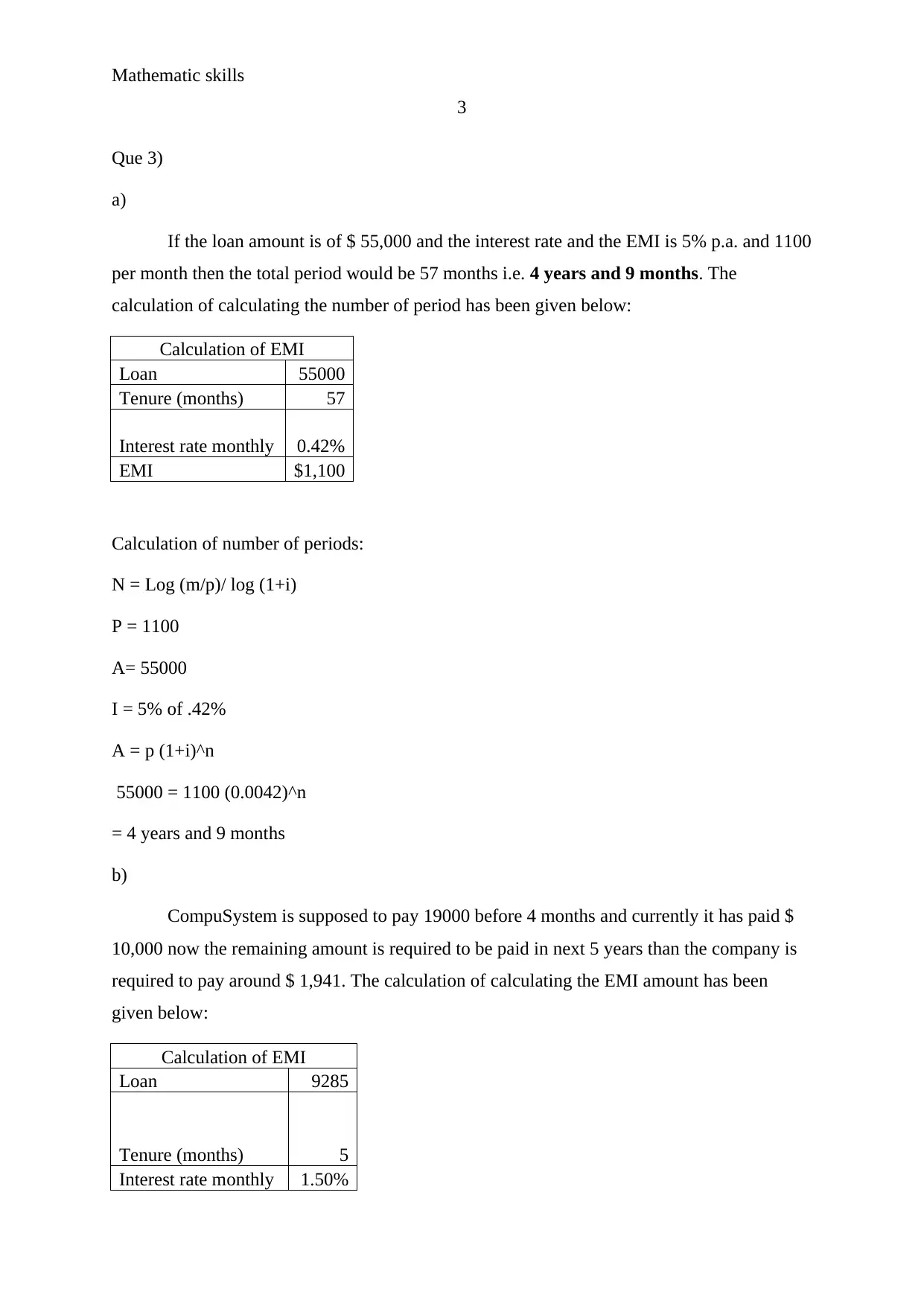
Mathematic skills
3
Que 3)
a)
If the loan amount is of $ 55,000 and the interest rate and the EMI is 5% p.a. and 1100
per month then the total period would be 57 months i.e. 4 years and 9 months. The
calculation of calculating the number of period has been given below:
Calculation of EMI
Loan 55000
Tenure (months) 57
Interest rate monthly 0.42%
EMI $1,100
Calculation of number of periods:
N = Log (m/p)/ log (1+i)
P = 1100
A= 55000
I = 5% of .42%
A = p (1+i)^n
55000 = 1100 (0.0042)^n
= 4 years and 9 months
b)
CompuSystem is supposed to pay 19000 before 4 months and currently it has paid $
10,000 now the remaining amount is required to be paid in next 5 years than the company is
required to pay around $ 1,941. The calculation of calculating the EMI amount has been
given below:
Calculation of EMI
Loan 9285
Tenure (months) 5
Interest rate monthly 1.50%
3
Que 3)
a)
If the loan amount is of $ 55,000 and the interest rate and the EMI is 5% p.a. and 1100
per month then the total period would be 57 months i.e. 4 years and 9 months. The
calculation of calculating the number of period has been given below:
Calculation of EMI
Loan 55000
Tenure (months) 57
Interest rate monthly 0.42%
EMI $1,100
Calculation of number of periods:
N = Log (m/p)/ log (1+i)
P = 1100
A= 55000
I = 5% of .42%
A = p (1+i)^n
55000 = 1100 (0.0042)^n
= 4 years and 9 months
b)
CompuSystem is supposed to pay 19000 before 4 months and currently it has paid $
10,000 now the remaining amount is required to be paid in next 5 years than the company is
required to pay around $ 1,941. The calculation of calculating the EMI amount has been
given below:
Calculation of EMI
Loan 9285
Tenure (months) 5
Interest rate monthly 1.50%
⊘ This is a preview!⊘
Do you want full access?
Subscribe today to unlock all pages.

Trusted by 1+ million students worldwide
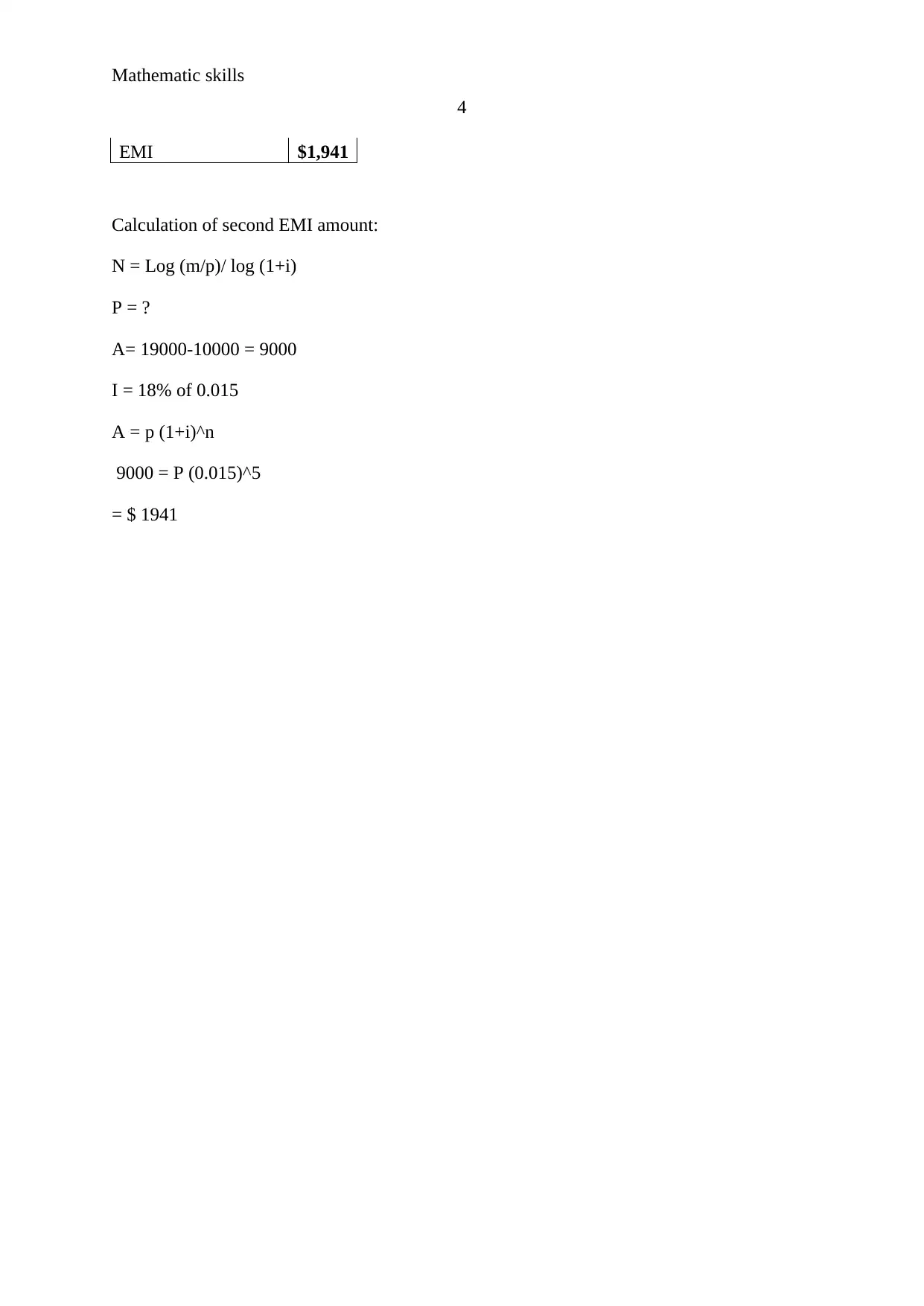
Mathematic skills
4
EMI $1,941
Calculation of second EMI amount:
N = Log (m/p)/ log (1+i)
P = ?
A= 19000-10000 = 9000
I = 18% of 0.015
A = p (1+i)^n
9000 = P (0.015)^5
= $ 1941
4
EMI $1,941
Calculation of second EMI amount:
N = Log (m/p)/ log (1+i)
P = ?
A= 19000-10000 = 9000
I = 18% of 0.015
A = p (1+i)^n
9000 = P (0.015)^5
= $ 1941
Paraphrase This Document
Need a fresh take? Get an instant paraphrase of this document with our AI Paraphraser
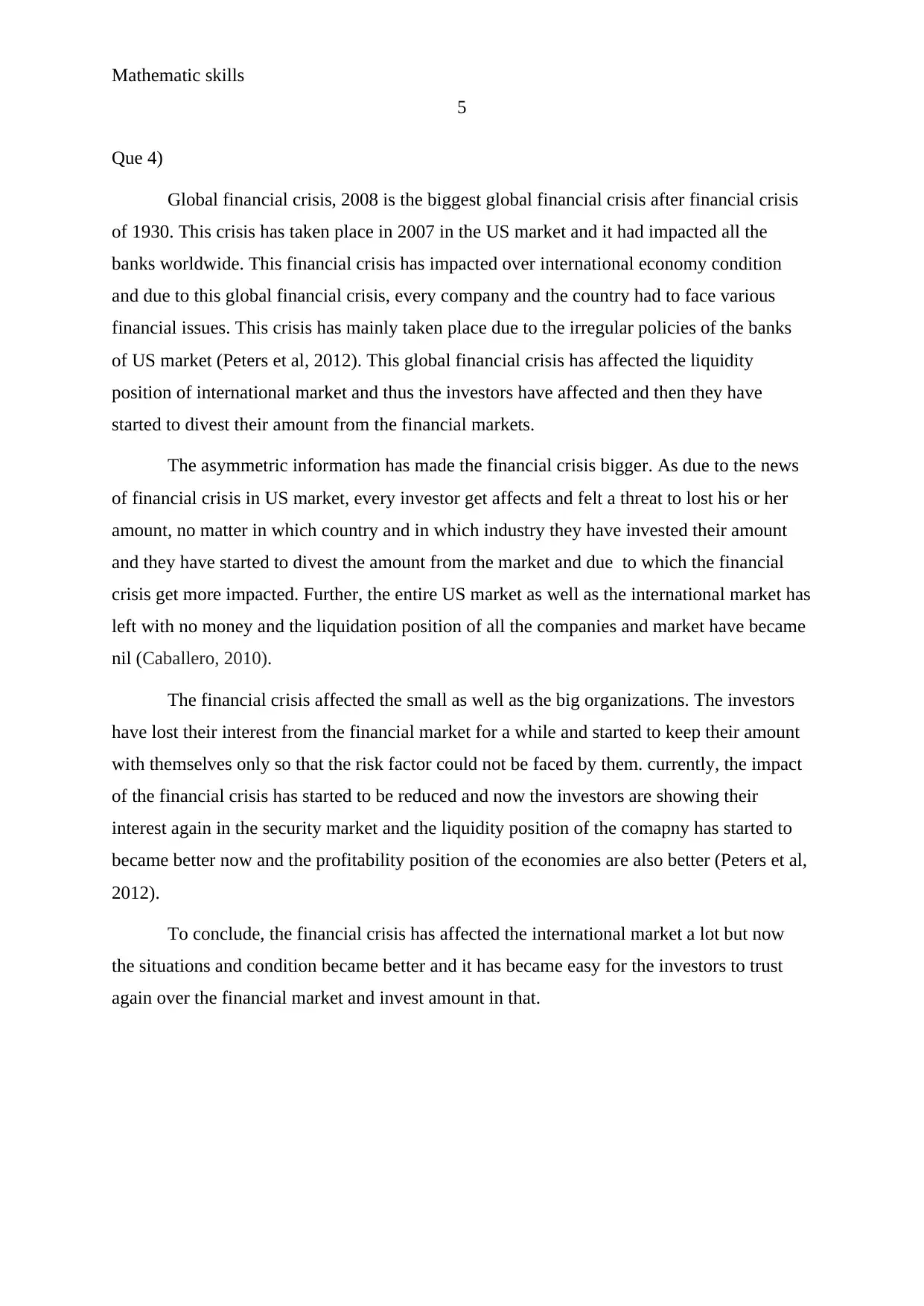
Mathematic skills
5
Que 4)
Global financial crisis, 2008 is the biggest global financial crisis after financial crisis
of 1930. This crisis has taken place in 2007 in the US market and it had impacted all the
banks worldwide. This financial crisis has impacted over international economy condition
and due to this global financial crisis, every company and the country had to face various
financial issues. This crisis has mainly taken place due to the irregular policies of the banks
of US market (Peters et al, 2012). This global financial crisis has affected the liquidity
position of international market and thus the investors have affected and then they have
started to divest their amount from the financial markets.
The asymmetric information has made the financial crisis bigger. As due to the news
of financial crisis in US market, every investor get affects and felt a threat to lost his or her
amount, no matter in which country and in which industry they have invested their amount
and they have started to divest the amount from the market and due to which the financial
crisis get more impacted. Further, the entire US market as well as the international market has
left with no money and the liquidation position of all the companies and market have became
nil (Caballero, 2010).
The financial crisis affected the small as well as the big organizations. The investors
have lost their interest from the financial market for a while and started to keep their amount
with themselves only so that the risk factor could not be faced by them. currently, the impact
of the financial crisis has started to be reduced and now the investors are showing their
interest again in the security market and the liquidity position of the comapny has started to
became better now and the profitability position of the economies are also better (Peters et al,
2012).
To conclude, the financial crisis has affected the international market a lot but now
the situations and condition became better and it has became easy for the investors to trust
again over the financial market and invest amount in that.
5
Que 4)
Global financial crisis, 2008 is the biggest global financial crisis after financial crisis
of 1930. This crisis has taken place in 2007 in the US market and it had impacted all the
banks worldwide. This financial crisis has impacted over international economy condition
and due to this global financial crisis, every company and the country had to face various
financial issues. This crisis has mainly taken place due to the irregular policies of the banks
of US market (Peters et al, 2012). This global financial crisis has affected the liquidity
position of international market and thus the investors have affected and then they have
started to divest their amount from the financial markets.
The asymmetric information has made the financial crisis bigger. As due to the news
of financial crisis in US market, every investor get affects and felt a threat to lost his or her
amount, no matter in which country and in which industry they have invested their amount
and they have started to divest the amount from the market and due to which the financial
crisis get more impacted. Further, the entire US market as well as the international market has
left with no money and the liquidation position of all the companies and market have became
nil (Caballero, 2010).
The financial crisis affected the small as well as the big organizations. The investors
have lost their interest from the financial market for a while and started to keep their amount
with themselves only so that the risk factor could not be faced by them. currently, the impact
of the financial crisis has started to be reduced and now the investors are showing their
interest again in the security market and the liquidity position of the comapny has started to
became better now and the profitability position of the economies are also better (Peters et al,
2012).
To conclude, the financial crisis has affected the international market a lot but now
the situations and condition became better and it has became easy for the investors to trust
again over the financial market and invest amount in that.
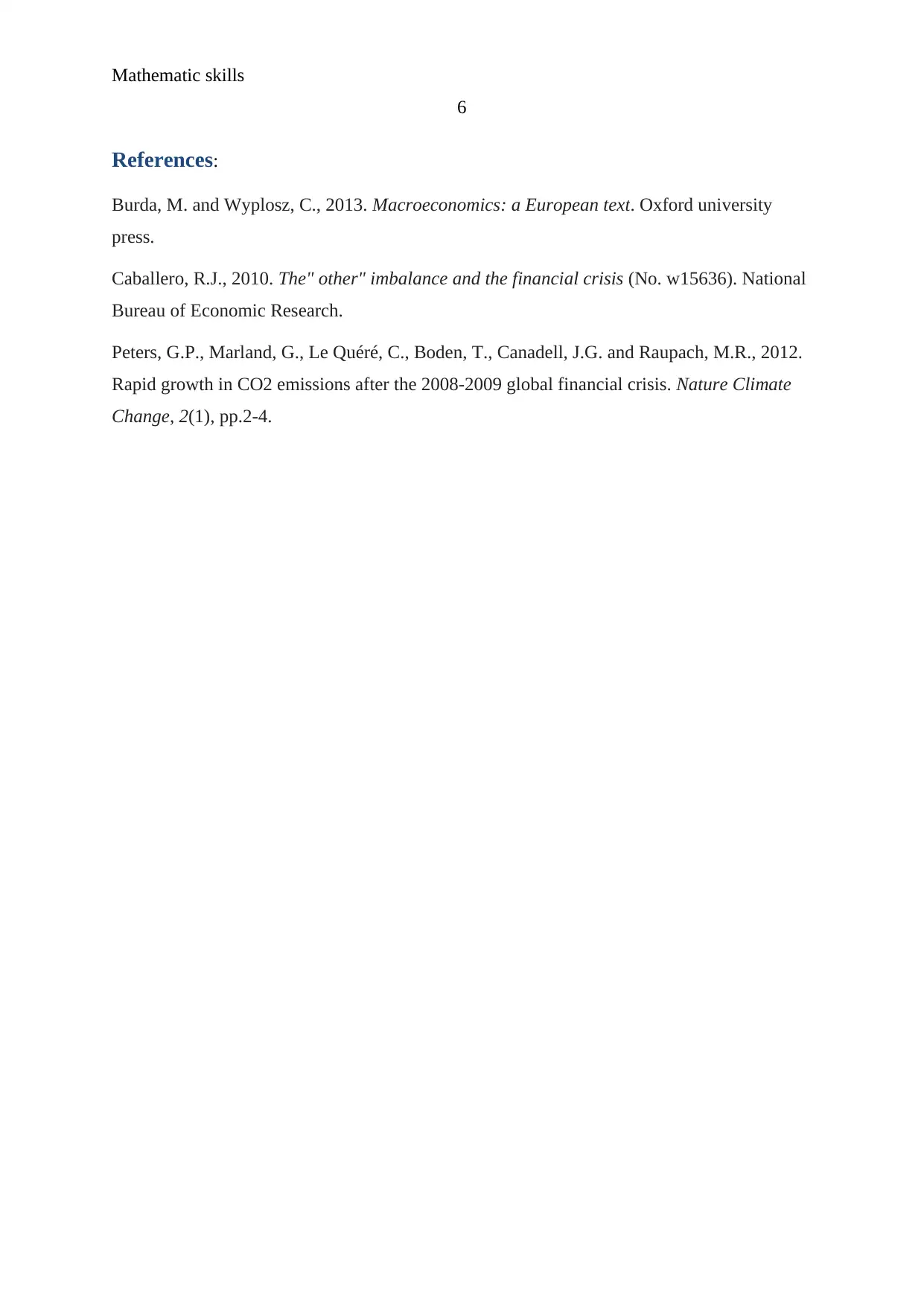
Mathematic skills
6
References:
Burda, M. and Wyplosz, C., 2013. Macroeconomics: a European text. Oxford university
press.
Caballero, R.J., 2010. The" other" imbalance and the financial crisis (No. w15636). National
Bureau of Economic Research.
Peters, G.P., Marland, G., Le Quéré, C., Boden, T., Canadell, J.G. and Raupach, M.R., 2012.
Rapid growth in CO2 emissions after the 2008-2009 global financial crisis. Nature Climate
Change, 2(1), pp.2-4.
6
References:
Burda, M. and Wyplosz, C., 2013. Macroeconomics: a European text. Oxford university
press.
Caballero, R.J., 2010. The" other" imbalance and the financial crisis (No. w15636). National
Bureau of Economic Research.
Peters, G.P., Marland, G., Le Quéré, C., Boden, T., Canadell, J.G. and Raupach, M.R., 2012.
Rapid growth in CO2 emissions after the 2008-2009 global financial crisis. Nature Climate
Change, 2(1), pp.2-4.
⊘ This is a preview!⊘
Do you want full access?
Subscribe today to unlock all pages.

Trusted by 1+ million students worldwide
1 out of 6
Your All-in-One AI-Powered Toolkit for Academic Success.
+13062052269
info@desklib.com
Available 24*7 on WhatsApp / Email
![[object Object]](/_next/static/media/star-bottom.7253800d.svg)
Unlock your academic potential
Copyright © 2020–2025 A2Z Services. All Rights Reserved. Developed and managed by ZUCOL.
